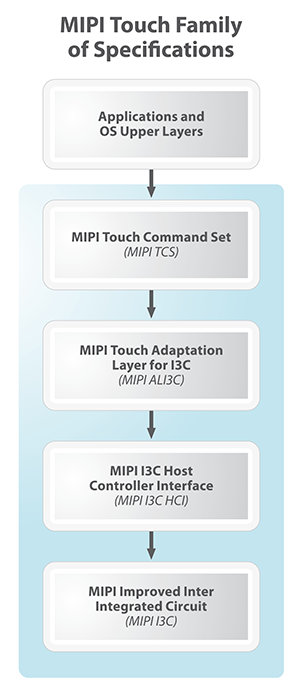A family of four specifications that standardize touch integration in mobile designs
 MIPI TouchSM is a family of four publicly available specifications that work together, as a system, to enable faster, more flexible design and implementation of touch applications in devices that use a display as the primary user interface. The specifications optimize the integration and performance of touch technologies in smartphones, tablets, laptops, computers, automotive systems and many other applications.
MIPI TouchSM is a family of four publicly available specifications that work together, as a system, to enable faster, more flexible design and implementation of touch applications in devices that use a display as the primary user interface. The specifications optimize the integration and performance of touch technologies in smartphones, tablets, laptops, computers, automotive systems and many other applications.
The MIPI Touch specifications
MIPI Touch is ideal for new designs that use the MIPI I3C sensor interface. The family of specifications includes:
- The MIPI Touch Command Set (MIPI TCS), a set of high-level commands that harmonize the writing of device drivers across operating systems.
- The MIPI Touch Adaptation Layer for I3C (MIPI ALI3C), which translates the touch commands for use on the MIPI I3C protocol.
- The MIPI I3C Host Controller Interface (MIPI I3C HCI), an optional specification for advanced systems that makes it possible to use touch commands and multiple data streams to add differentiating touch features to a design. Application processor companies can apply the specification to standardize the HCI method used in their devices.
- The MIPI I3C v1.0 specification, which connects an application processor to a touch sensor.
MIPI Touch provides significant interoperability conveniences that alleviate previous challenges associated with touch, sensor and software integration the broad and diverse device market. A primary benefit is a standardized write “write once” approach that enables a developer to write a single driver that can be used across operating systems for touch implementations in a wide range of devices. MIPI Touch also provides significant performance benefits: When all four specifications are used as a solution, it yields the highest throughput and lowest latency for touch products.
You can download the MIPI Touch specifications by submitting the form on this page. Visit the MIPI Alliance website to learn more about MIPI Touch, as well as the entire portfolio of MIPI specifications.
